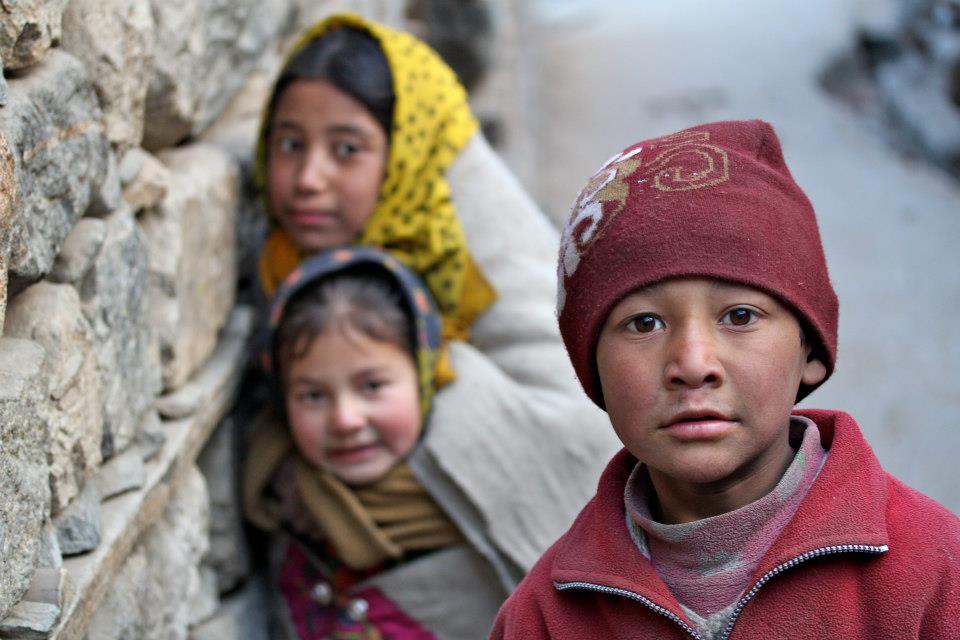- Regular Price
- £19.99
- Sale Price
- £19.99
- Regular Price
- £19.99
- Unit Price
- per

The masterpiece Ladakhi pashmina shawl pictured above was inspired by mandalas made in monasteries by Buddhist monks. It took three years to create. It is said to have energy chakras and is considered a sacred work of art.


For centuries, skilled craftsmen have been weaving and embroidering pashmina shawls in Ladakh, a very remote region in the Himalayan mountains, part of the Kashmir region in northern India, on the border with Pakistan.

The lives of these men and their families are harsh and it is from this harshness that such skill and beauty is born.

These beautiful pashminas start their life at the top of the Himalayan mountains and make their journey down to the heavenly Kashmir Valley, moving from one specialist village to another, passing from skill to skill during the process of their fabrication.

Our supplier, the intrepid Atul Kumar sent us these images of some of his rides, bringing pashminas down from the mountains.



From one of his posts,
"...Khardungla it was hell of of ride !! No rider reached that day on the top, But who could have stop ladakhi. Fell more than 20 times from South to North pullu. But it was more of strong and intimate ride 😂😂😂"

The treacherous terrain, almost impassable passes, ice cold river fords and snow covered roads, to say nothing of the unpredictable weather, all make for a dangerous journey by any standard.
Each hand embroidered shawl makes its own individual journey and carries its own unique history.

Mr Kumar has has helped set up a project in the region to support the local people, offering training and ensuring they are treated fairly.
By buying one of these exquisite pashminas, not only are you investing in a heritage piece but you’re also contributing to the sustainable lifestyle of these nomadic people so they can continue their centuries old traditions and way of life.
We will are working with our suppliers to ensure that a contribution from each sale of these shawls goes in direct funding to support communities in Ladakh and Nepal. This is still under development and we will publish updates in due course, but in the meantime we are committing to saving 5% of the proceeds of each shawl for these causes.
Considered to be the finest pashminas in the world, these shawls are also known as ‘Soft Gold’ due to the superiority of the cashmere wool and the incredible intricacy of the embroidery. Kashmir produces only 1% of the world's annual "clip" of cashmere, but it is also the finest.
The patterns in these shawls are inspired by the flora, fauna and features of this vivid landscape. The long, fine fibres that are used to weave the textile come from the insulating undercoat of Changthangi goats herded by nomadic tribes in the Changthang desert - a hauntingly beautiful but fiercely hostile region of Ladakh and part of the Tibetan Plateau, where temperatures range from +35℃ (95℉) down to a bitter −35 °C ( −31 °F).
The goats live in small flocks, looked after by The Chang-Pa tribe who have farmed in this hostile environment for many centuries.

This precious and rare fibre comes from the kidgoats and is harvested only once in a goat’s lifetime. The wool is not shorn, but carefully combed, leaving the much coarser guard hairs in place and allowing the goat to live on in it natural environment for perhaps 11 more years.

After combing the baby goats (the wool used for this pashmina came from a herd of 230 owned by nomad farmer, Tsering Dolkar), the fibres are then separated by carding before being spun into a yarn by hand. Even for the most experienced and skilled spinner, it takes around a month to produce just 100 grams of yarn.

The weaving is done very slowly on very basic looms but exceeds the quality of even the most sophisticated western machinery and it can take up to a month to weave enough fabric for a shawl.

Dyeing is done in the yarn and in the piece, usually by one of the oldest dyers of Srinagar. (We are awaiting a photo of the old gent but this gives an idea.)

The fabric is then passed into the ‘golden hands’ of the master embroiderers who sew by hand the intricate patterns. The patterns are perfect on both sides, requiring patience, skill, mastery.
Each shawl has spent at least 3 months being hand-embroidered. This is three months of actual work, (around 400 man-hours), up to an incredible 18 months, (around 3,000 man-hours).
Now that’s what we at The Wool Company call great art. Thank you Mr Kumar!

We are genuinely proud to be able to offer these precious and unique hand embroidered Kashmiri shawls. We hope you will like them and all they represent.
1 comment
It is so important to have authenticity and respect for this great art which you do explain well .
So much machine made items are confusing and genuine items need a label a certificate of authenticity .
After all I am buying art work with handmade hard earned genius . I admire this art and only want yo support the artists that create these items .
I just got back from Delhi first trip there and it was a sea “of pashminas “ but which was which I did not know. Your information has been very valuable .It guides me to buy from you only genuine items .
What is Shamina type ..? People tried to sell me this at high price … but I had not heard of it ? Then antelope hair was mentioned but no longer available